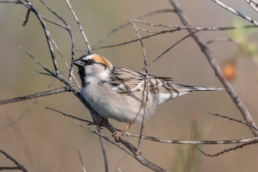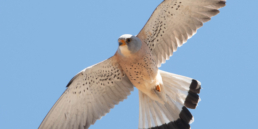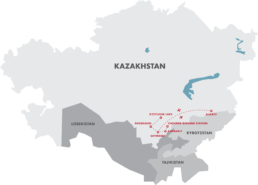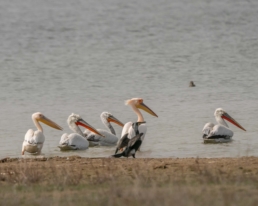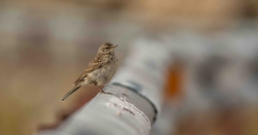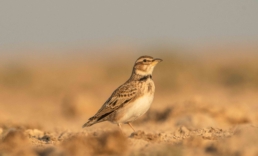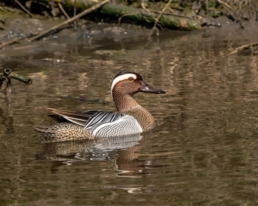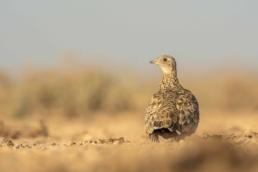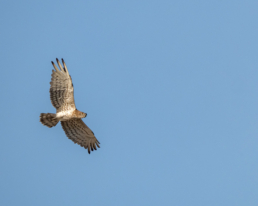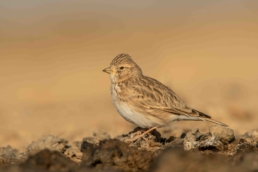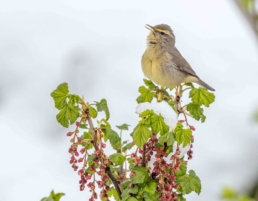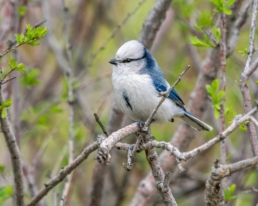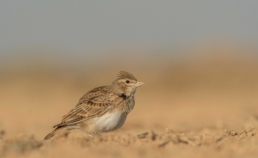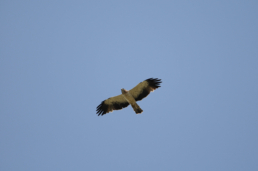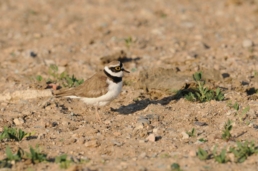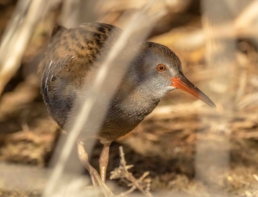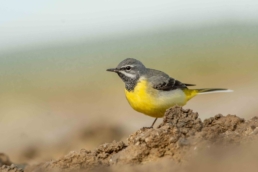Your Kazakstan itinerary
Day 1: To Almaty
Clients will depart from their home countries, heading to Almaty, the largest city in Kazakhstan. We recommend flying with Turkish Airlines via Istanbul, as they offer convenient connections to both Almaty and for your return from Astana. Please ensure you arrive in Almaty before 6:00 AM on September 12th. If you wish to arrive earlier, feel free to reach out to the RBT office; we are happy to assist with additional hotel bookings.
Night: Day 1, on aircraft
Day 2: Big Almaty Lake
We have a full day scheduled in this stunning high-altitude landscape to search for an incredible array of alpine specialists. Expect to see Black-throated, Altai, and Brown Accentors, Sulphur-bellied Warblers, Red-mantled Rosefinches, White-winged Grosbeaks, and the incomparable White-browed (Severtzov’s) Tit-Warbler!
We will descend a short distance by coach to Big Almaty Lake, where the extensive, braided, stony riverbeds are home to the unique Ibisbill. Look out for species such as Lammergeiers, Himalayan Griffons, Red-billed and Yellow-billed Choughs, Plain Mountain-Finches, and White-winged (Güldenstädt’s) Redstarts. Most of these species inhabit high mountain altitudes of around 10,500 feet. The star attraction today, which we have an excellent chance of spotting, is the regal Himalayan Snowcock.
In the early evening, we’ll enjoy a leisurely visit to the local park, where we can admire the historical Ascension Cathedral (also known as Zenkov’s Cathedral). This remarkable structure was built using ancient techniques, without a single nail! Its unique construction allowed the cathedral to survive the devastating earthquake that struck the city in 1910.
Night: Comfortable tourist hotel in Almaty
Day 3 - 5: Almaty to Dzhabagly & Chokpak Ringing Station
Today, we will fly west to Shymkent, arriving around noon. This is the third most populous city in Kazakhstan, located near the country’s first established nature reserve. A short drive will take us to the village of Dzhabagly, nestled in the foothills of the western Tien-Shan Mountains. After checking into the local guesthouse, we’ll acclimate to our new surroundings. The birding begins right here, as this charming village is ideally situated along a major migration route. On previous tours, we have spotted Yellow-breasted Azure Tits and Asian Paradise-Flycatchers in the guesthouse garden! We’ll quickly become familiar with common species such as Grey-crowned Goldfinches, White-crowned Penduline Tits, and Azure Tits. Along the main street, we may also discover gems like Eversmann’s Redstarts and Blue-capped Redstarts.
The first few days of the tour are designed to allow us flexibility in our exploration. The fertile agricultural fields surrounding the village are prime spots for spotting Siberian Stonechats, Pied Wheatears, Red-tailed Shrikes, and large flocks of Pine Buntings, which winter in the Tien Shan foothills. We may even see the first Black-throated Thrushes returning from Siberia. Weather permitting, we plan to visit Ulken Kaindy Gorge, where the dry, rocky slopes and juniper scrub may yield sightings of White-capped Buntings, Rufous-naped Tits, Red-mantled Rosefinches, and, hopefully, more stunning Yellow-breasted Azure Tits. In Berkara Gorge, we’ll aim to add Eastern Rock Nuthatches to our list, with Asian Paradise-Flycatchers as a delightful bycatch. Long-legged Buzzards will still be numerous this time of year, and we may spot the colourful Egyptian Vulture.
In the expansive reedbeds of Taskol, we will listen for the distinctive calls of Clamorous Reed Warblers, hoping to catch our first glimpses of the White-headed Duck. Birdwatching for raptors in the fall is heavily influenced by the wind conditions, so we will decide each morning which options to pursue. The nearby mountain bottleneck is ideally positioned for northeast winds, which are favourable for migrating raptors. This bottleneck funnels birds across the fields near the village, providing us excellent opportunities to view Montagu’s and Pallid Harriers, as well as the possibility of Shikras, Steppe Buzzards, Steppe Eagles, and Crested Honey Buzzards.
Night: Comfortable guesthouse Dzhabagly
Day 6 - 8: Lake Shoskakol
Today, we continue our journey westward towards Turkestan, making birdwatching stops along the way to observe any interesting species. Upon our arrival in Turkestan, we will visit the Mausoleum of Khawaja Ahmed Yasawi. This stunning structure is adorned with glazed tiles and turquoise ornamentation, characteristic of the Timurid architectural style. It is one of the best-preserved monuments from that era and has become a symbol of Kazakh national identity. After exploring the mausoleum, we will head to the Shoskakol Lake system. During migration periods, this area attracts a variety of unusual species that use the lakes as a resting point on their southward journeys. It’s an excellent spot for wildfowl, where we may encounter Garganey, Ferruginous Ducks, Red-crested Pochards, and White-headed Ducks. We can also expect to see Glossy Ibises, Little Bitterns, and the beautiful Black-crowned Night Heron.
In the semi-desert regions surrounding Shoskakol, we will look for our first larks, including Calandra and Bimaculated Larks. We will also venture closer to the Uzbek border in search of the delightful Streaked Scrub Warbler. We will dedicate one full day to exploring the sandy deserts characterized by Saxaul vegetation in pursuit of one of Kazakhstan’s most sought-after species—the superb Turkestan Ground Jay! If we are fortunate, we might also spot an Asian Desert Warbler, although many of these migratory birds will have left the area by this time.
After our daily adventures, we will return to Turkestan each evening to enjoy the comforts of a delightful hotel.
Night: Comfortable tourist hotel in Turkestan
Day 9 - 10: Kyzylkum Lake
Today, we embark on an exciting adventure to Lake Kyzylkum, a picturesque oasis nestled in the heart of an expansive desert. This small lake attracts a multitude of migratory birds, making it a vital stopover for avifauna from various regions. The surrounding landscape is flat and sandy, dotted with small scrubs and wormwood, and is alive with birds at this time of year. As we explore the area, we can expect to encounter a variety of shrikes, warblers, larks, pipits, and buntings. The vibrant Blue-cheeked Beef-eater is often spotted here, and we’ll be on the lookout for migrating Booted Warblers and Sykes’s Warblers. Occasionally, we might also see the more elusive Upcher’s Warbler and Menetries’s Warbler.
The lake can host impressive numbers of White-headed Ducks, with the largest recorded group reaching 2,000 individuals—representing a staggering 20% of the global population of this beautiful species. Tens of thousands of Yellow Wagtails, particularly the ‘beema’ race, are commonly found around the lake, adding to the vibrant avian display. Waders are also abundant, with Red-necked Phalaropes and Ruffs often seen in large numbers. After a full day of birdwatching, we will retire to a basic hotel in a nearby village, reflecting on the day’s adventures and the incredible wildlife we’ve encountered.
Night: Basic hotel Cholak Korgan
Day 11: Return to Dzhabagly
Today, we retrace our steps back to Dzhabagly for our final day of exploration. We’ll revisit the areas we discovered during the first part of our trip, but with a twist: as we’re now later in the month, we can expect to see a significant increase in eagle migrations over the village. We’ll be on the lookout for majestic birds such as the Steppe Eagle, Eastern Imperial Eagle, and Greater Spotted Eagle, all of which are known to dominate the skies at this time. Additionally, we hope to catch sight of the exciting Oriental Honey-buzzard, known for its striking plumage and graceful flight.
The number of Black-throated Thrushes will also have increased by now, as these beautiful birds arrive in Kazakhstan for the winter. With a day filled with birdwatching and the opportunity to witness these magnificent eagles, it’s a perfect way to conclude our adventure in this stunning region.
Night: Comfortable guesthouse Dzhabagly
Day 12: Back to Almaty
We begin our last day with some final birding around the lodge, immersing ourselves in the morning’s sights and sounds. After our birdwatching session, we will embark on a short drive back to Shymkent, where we’ll connect with our domestic flight to Almaty.
In the evening, we’ll come together for a delightful farewell dinner, savouring traditional shaslik while making toasts to celebrate the incredible experiences and memories we’ve shared throughout our journey. This is the perfect way to wrap up our adventure in Kazakhstan, reflecting on the breathtaking landscapes and the diverse birdlife we’ve encountered.
Night: Comfortable tourist hotel in Almaty
Day 13: Return to home
A transfer will be provided very early this morning to Almaty International Airport (ALA) to catch your Turkish Airlines flight to Istanbul, which is currently scheduled to depart at 3:20 AM.
Night: No lodging
Tour information
Focus
- Birds
- Mammals
- Vast unique landscapes
Group size
Min 6 - Max 10
The group will be led by one birding leader and one culture guide at all times.
What's included in the Price?
All transport, including the domestic flight between Almaty and Astana. All accommodations in twin rooming. All meals. All permits and national park entrances. Please note: Drinks, tips, possible visas and items of a personal nature including travel insurance, are not included.
Accomodation
Throughout our journey in Kazakhstan and Kyrgyzstan, we will venture primarily off the beaten track, immersing ourselves in the authentic beauty and culture of these remarkable countries. While Kazakhstan is renowned for its stunning vast landscapes, rich culture, and hospitable people, its tourism infrastructure is still developing. In Almaty, we will be accommodated in a comfortable tourist hotel with private facilities, providing a restful retreat after our adventures. As we travel through the Charyn and Astana regions, our accommodations will be more basic, offering shared facilities. These accommodations typically feature simple, clean rooms with basic amenities such as a shared bathroom and WC, ensuring our comfort during our explorations.
During our exploration of the Taukum Desert sites, we will experience the enchantment of camping under the stars in Rubythroat’s operated private yurt camp. We are the ONLY company offering this style of accommodation. Other companies use tents. Yurts are shared, and we will provide separate shower yurts and Western-style WC facilities. While the camping experience offers a unique opportunity to connect with nature, please note that washing facilities are basic. However, we will provide suitable warm sleeping bags to ensure a comfortable night’s rest under the open sky.
In Kyrgyzstan, our accommodations will include overnight stays in comfortable tourist hotels located in the heart of the city, providing a convenient and restful retreat after our adventures in this breathtaking country.
Difficulty
During our expeditions, we may embark on long journeys, some of which may traverse poor or unpaved roads. However, these extensive travels serve to highlight the vastness and adventure of the region. Throughout the journey, we’ll travel in comfort using a reliable coach for transportation. When it comes to walking, the tours are designed to be primarily easy to moderate, even in the high elevations of the Tien Shan Mountains. Most of our walking excursions involve short distances on flat terrain or downhill paths, ensuring that participants can comfortably explore the stunning landscapes and natural wonders of Central Asia.
Flights
International flights are not included in the pricing. Please connect with the RBT office to find out your best connection to Central Asia.
Clothing - What to pack?
For our expedition to Central Asia, it’s important to pack a variety of clothing to accommodate the diverse climates and activities we’ll encounter. Lightweight, easily washable, and quick-drying clothes are essential for the hot steppe and desert regions, along with sunglasses and a sun hat for sun protection. However, don’t forget to pack some lightweight yet warm layered clothing for higher altitudes, where temperatures can drop significantly. This includes a warm hat, fleece, and light gloves to keep you cosy. Additionally, a light waterproof jacket is recommended to shield against unexpected rain showers. When it comes to footwear, opt for light yet sturdy walking boots that can handle various terrains. It’s advisable to avoid shorts to protect yourself from the sun, as the region can be conservative in dress. While people in the cities tend to dress more casually in Western clothing, it’s still a good idea to respect local customs by dressing modestly. If needed, laundry facilities are available at hotels in larger towns such as Karakol, Almaty, and Astana, offering convenience for longer stays.
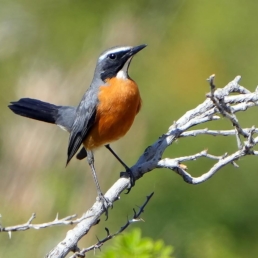
Related tours
Ornithological expedition in the Kazakh Altai
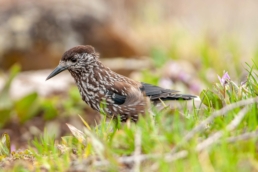
The Flora & Fauna of Altai
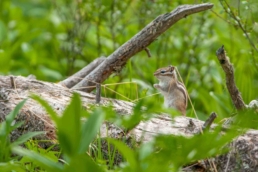
Floating hide Photography expedition
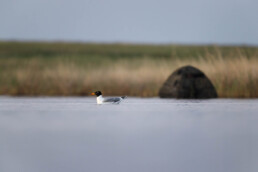
Spring migration in Central Asia
